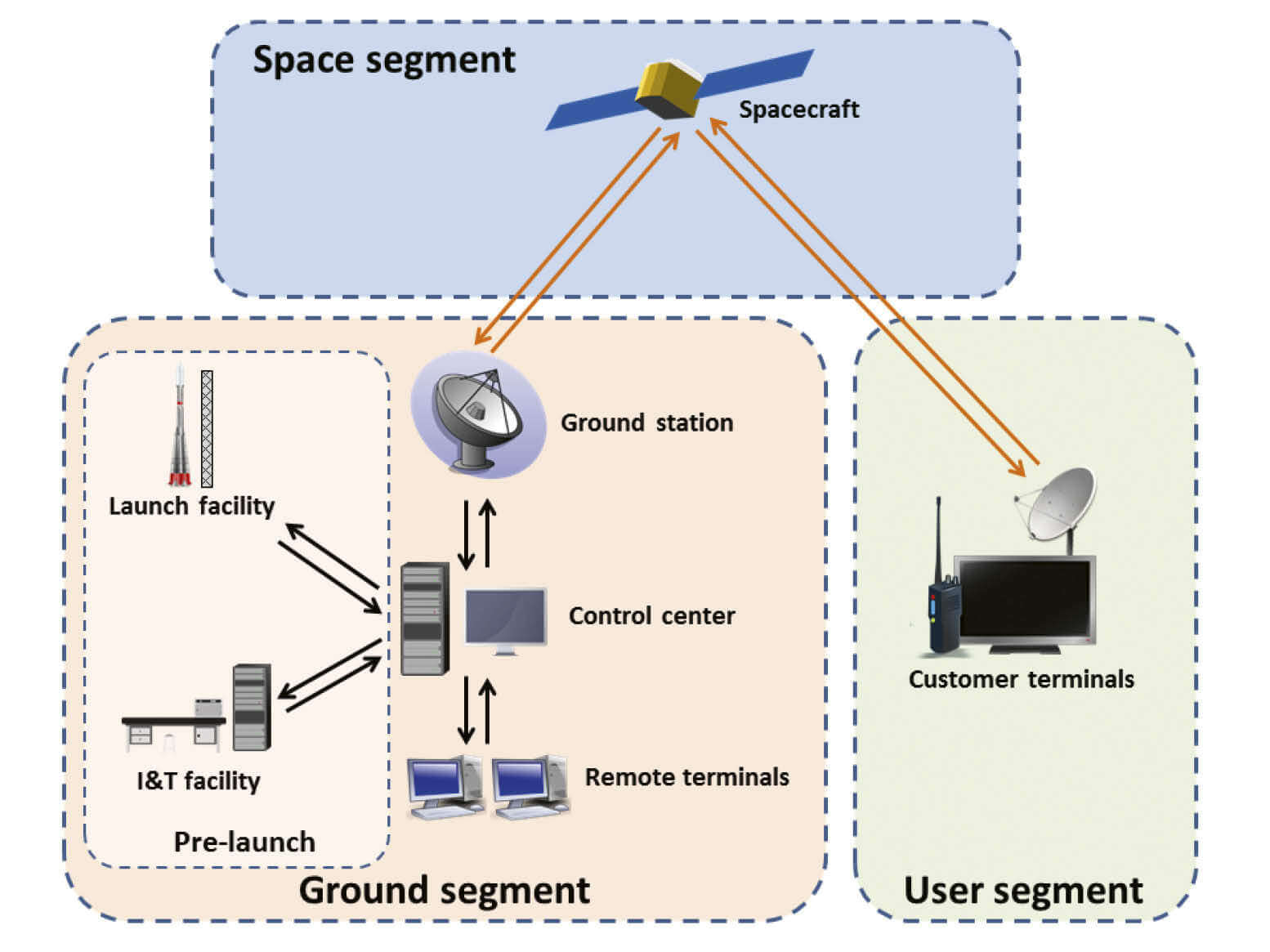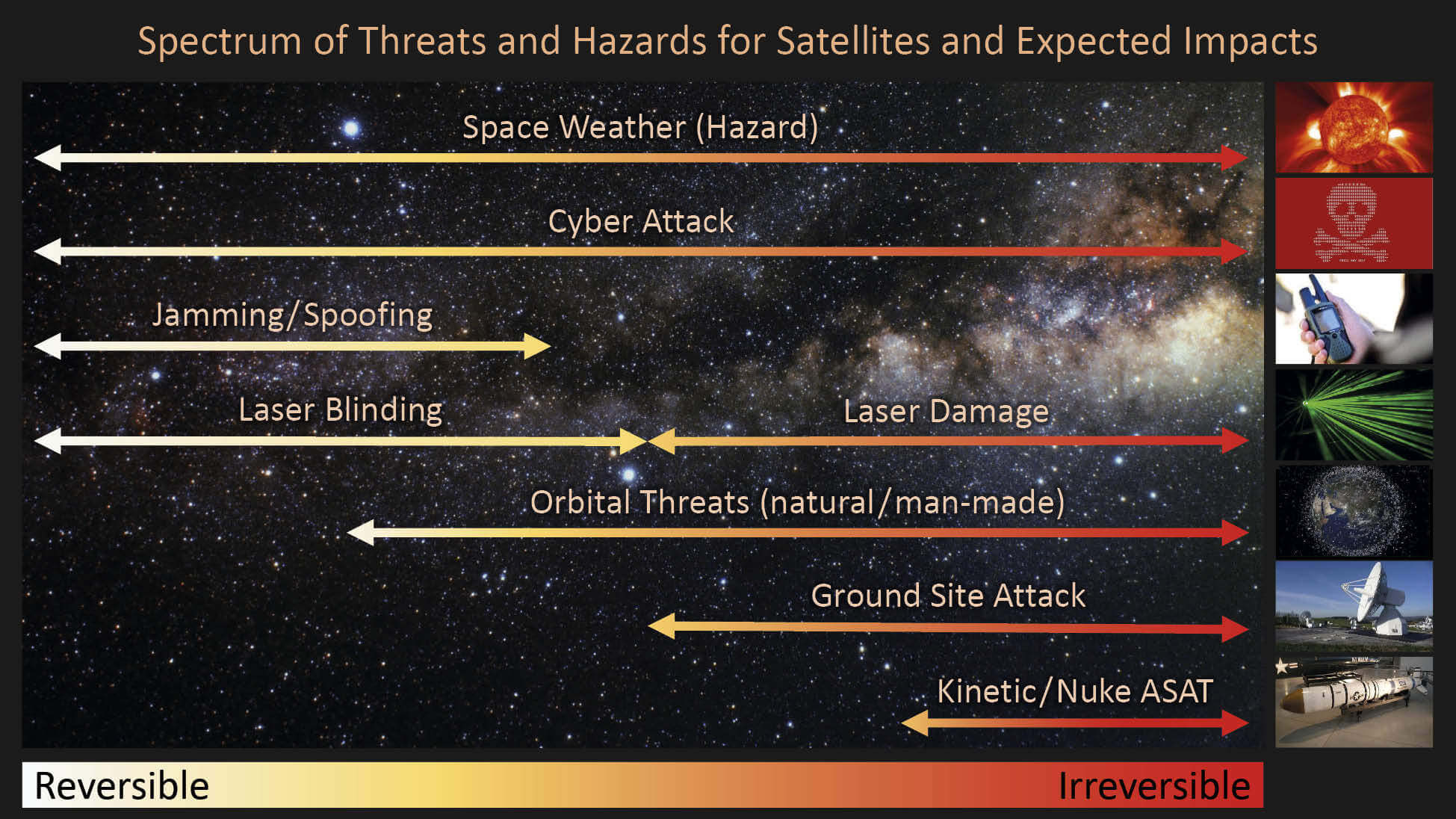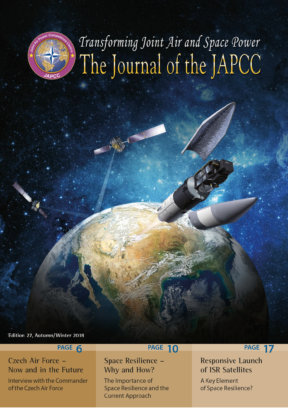Introduction
Modern warfare is highly reliant on Space. From GPS-guided munitions to Communications and Intelligence, Surveillance and Reconnaissance (ISR), Space is almost ubiquitous when high-tech military applications are involved. The relevance of space-based services for military operations has grown to a point that NATO admits its substantial dependency on the domain. 1 For these reasons, most commanders assume the presence of space support in any operation, yet only a few have a clear understanding of its contributions, let alone the consequences of an interruption or significant degradation of any of the space services. In this context, raising awareness across the Alliance of its dependency on Space remains a challenging task, and thus a primary objective for the NATO space community.
Space Support as a Requirement – Space Resilience as Deterrence
When confronting a space-capable, near-peer adversary, an absence of space support would result in a dangerous technological gap, because of the unavailability of many types of military equipment that require some form of space-based product or service. Consequently, being prepared to operate in the absence of space support is important, but it is not enough. In fact, the ability to go ‘back to basics’ (i.e. to employ ‘old-style’ Tactics, Techniques and Procedures (TTP) when it is the only available option) is a necessity because it allows operations to continue even in a highly degraded space support environment; nevertheless, it also implies some degree of capability deterioration that, in some cases, could be unacceptable for the effective conduct of operations.

Not only is space support critical to military operations, but it is also an important element of deterrence, as vulnerabilities in space support to operations seriously impair deterrence. An opponent aware that Alliance high-technology capabilities depend on an exposed space infrastructure will be, in fact, encouraged to undertake hostile actions, primarily against such infrastructure. A clear commitment to preserving military space support through the improvement of its resilience, therefore, should be a priority.
Unfortunately this is not an easy job, because satellites operate in a condition of intrinsic fragility: they orbit at an incredible speed (up to 28,000 km/h) in a high thermal and electromagnetic stress environment, with limited capability to manoeuvre, and under the constant threat of collision with other natural and man-made space objects. Moreover, from a military point of view, satellite systems have an additional vulnerability. In fact, unlike most military assets, nations need to deploy their satellites and their respective ground segments and put them into service well before they can be effectively employed in any military operation. This means that an adversary has the time to thoroughly study all system characteristics, understand behaviours, find weaknesses, and determine the best way to neutralize a key space-based service. Space systems are usually very expensive and take years for governments or industry to develop and make operational; furthermore, they are difficult to defend and take a long time to replace. In a nutshell, they represent a low-risk/high-reward military target. In addition, the wide spectrum of all possible threats to space systems, from cyber-attacks to kinetic attacks, to the use of Directed-Energy Weapons (DEW), allows the adversary to escalate and de-escalate the aggression intensity quickly and effectively.
Consequently, it is quite reasonable that space services should be acknowledged as a predictable day-zero target, because an adversary can clandestinely prepare space assets as targets during peacetime, then rapidly attack them, when required, to provide heavy impact to the Alliance forces and achieve significant surprise effect. An attack on dual-use or civil space systems would be highly disruptive as well. Today, for example, the sudden loss of satellite-based Position, Navigation and Timing (PNT) services or of satellite communication would paralyse most of the financial, commercial, and transportation systems and associated activities. 2
Resilience: Current Techniques
Once one accepts that space-based services are an indispensable but vulnerable military resource, and that they represent a high-profile military target for an opponent, the next question is how to pursue the desired level of mission assurance despite this constant threat.
The military answer is straightforward: defensive operations. However, since NATO has not yet recognized space as an operational domain nor released a space policy, NATO space doctrine remains, predictably, incomplete, and in particular regarding space defence. Nevertheless, the well-developed NATO doctrine for air and space operations, specifically for Defensive Counter-Air (DCA) operations, can provide a source of inspiration for this particular aspect of the space operations doctrine. 3 Specifically, the aim of space defensive operations is to reduce the risk of damage to Alliance systems, both in terms of likelihood and impact. It should be noted that, since space systems usually consist of space, ground and user segments, defensive operations for space systems are not limited to the space environment, but can occur in multiple operational domains.
Space defence, as with air defence, comprises active and passive defence measures. Active measures aim at reducing the likelihood of an attack by destroying, nullifying or reducing a hostile threat. They imply the use of some kind of weapon, including kinetic, laser, electronic or even cyber. On the other hand, passive defence refers to a long list of possible countermeasures that do not imply the use of weapons. It includes resilience improvement, reconstitution procedures, and concealment and deception techniques.
Even without an official definition in NATO, resilience (or resiliency) is commonly understood as robustness and survivability, i.e. the ability of a system to continue to operate or to rapidly recover after a disturbance of any kind and from any source to an acceptable level of service. Reconstitution is slightly different, because it implies the launch of additional satellites or the activation of additional ground stations to restore a damaged space-based service, and thus it requires specific additional capabilities such as ‘responsive launch’ (for more on this topic see the article ‘Responsive Launch of ISR Satellites.’). In this sense, there is a sort of trade-off between resilience and reconstitution. For a given mission assurance requirement, the better your capability to promptly reconstitute a system, the less resilience you need. Concealment and deception methods, which include various techniques to hide assets and capabilities or to mislead the opponent, are outside the scope of this article.
Resilience can be achieved through several complementary approaches. The list below aims at identifying and defining the currently available options according to prevalent nomenclature. It is not the only possible set of definitions; it simply serves to illustrate specific concepts related to resilience to provide a sufficient conceptual framework for analysis.4
Disaggregation5, 6 is the allocation of different missions, functions or sensors across separate subsystems, in space or on the ground (ground and user segment). In this way, targeting a single element of the system will only partially affect the capability. Additionally, its reconstitution will be faster and cheaper, since governments or industry can easily install lightweight subsystems as additional hosted payloads on larger satellites. In short, disaggregation improves deterrence because it increases the effort required of the attacker to bring down the whole system. Disaggregation also facilitates repair and upgrading because the system owner can intervene individually on component subsystems of a larger disaggregated system.
Distribution is similar to disaggregation but, in this case, the separate subsystems perform the same mission and collectively behave as a single system. The US Global Positioning System (GPS) is a good example of a distributed system. Attacking a single satellite only slightly decreases the overall system performance (graceful degradation) and all the original system functions remain available. Distributed systems improve deterrence by increasing the cost/benefit ratio for an aggressor: they represent an expanded target – thus harder to destroy – and they are relatively easy and fast to reconstitute.
Diversification is the ability to contribute to the same mission/function in multiple ways. Commercial, civil, or international partners can achieve it by using different platforms, orbits, systems, and/or capabilities. A good example of diversification is the possibility to obtain PNT services from different sources, such as GPS, Galileo, the GLobal Orbiting NAvigation Satellite System (GLONASS), etc. It is worth noting that diversification can also take advantage of alternative- or cross-domain solutions. High-Altitude Platform Systems (HAPS), for instance, can be deployed quickly in the case of sudden space system unavailability to substitute for or integrate into a space-based Global Navigation Satellite System (GNSS), or to contribute to long-range communications. Enhanced LOng RAnge Navigation (E-LORAN),7 with its dedicated receiver, is another alternative-domain solution for navigation, while Inertial Measurement Units (IMUs) can provide independent positioning and navigation, even if their precision degrades in the long-term.8 In short, diversification is focused on improving the resilience of a service rather than of a specific system.

Proliferation is the distribution of multiple units of the same system (or segment, or component) to provide technical redundancy to handle an event like a failure or an attack. Proliferation can be applied not only to satellites but also to components of the ground and user segment. In a nutshell, since any redundant element can individually ensure the required capability, it is harder for the opponent to tear the entire system down.
Protection embraces all passive measures that make the satellite system intrinsically more robust, such as physical or electromagnetic hardening. It also includes systems to protect the link segment from jamming and other forms of interference, as well as software techniques, like the encryption of the communication channel. Additionally, the availability of built-in capabilities for detecting and assessing possible attacks, as well as improved manoeuvrability to avoid them, can also be considered as protection-oriented features.
As stated, the above list provides a short overview of the possible approaches to a resilient design. Note that these measures are not mutually exclusive; on the contrary, the coupling of different approaches multiplies their effectiveness. For example, one can apply proliferation, diversification, and protection to a set of commercial and military systems to provide cost-effective, resilient satellite communications. It is also worth noting that some resilient approaches actually can facilitate the implementation of additional resilience measures. For instance, a disaggregated system easily can implement protection, diversification and/or proliferation measures, too, because it relies on simpler components that are easier to replicate or upgrade. In this regard, however, there is an essential constraint to keep in mind: in principle, the satellite owner may decide to implement some resilience measures, such as diversification and proliferation, at any time, but most of them can only be introduced during the initial design phase. For example, implementing disaggregation, distribution and protection after the launch is usually unviable – at least with respect to the satellite segment.
Resilience in the NATO Perspective
The 2016 ‘Warsaw Summit Communiqué’9 and in particular the relevant ‘Commitment to enhance resilience’10 clearly attests that resilience is already a major concern for the Alliance. This means that NATO’s space policy and strategy also should reflect this approach. Therefore, even if NATO is not expected to acquire its own satellite systems in the near future, it should exert its political influence to ensure that Alliance nations apply resilience concepts for the development of their space systems. On the strategic level, the approach should be slightly different. Since NATO is a space service/products consumer, its main concern is space resilience from a service perspective. Consequently, it should strongly foster the selection of resilient, redundant, and synergetic national space systems – commercial solutions included – to support NATO operations. The recent and long-awaited announcement11 of an agreement on developing an overarching NATO Space Policy is a very promising first step in the right direction.
Conclusion
Today, space support to military operations is so essential that its assurance has become a critical factor of NATO deterrence. This means that resilience, which is already a central topic in NATO, needs to be addressed with respect to space-based capabilities, not only at national levels, but also by the Alliance as a whole. In this context, the simple abdication of a capability (the ‘back to the basics’ approach) should no longer be considered a valid ‘plan B’, but the last resort. In fact, it should be clear at this point, that failing to achieve the combined resilience of national assets could pose a substantial threat to NATO effectiveness. Henceforth, it is paramount to exploit any existing synergies between available national systems, both military and commercial, to improve the resilience of space capabilities provided to the Alliance. Moreover, NATO should bring nations together to consider space resilience as a fundamental design driver for future systems and foster the creation of new synergies, perhaps through the establishment of specific Standardization Agreements (STANAGs).












